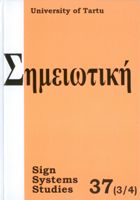Animals and music: Between cultural definitions and sensory evidence
Animals and music: Between cultural definitions and sensory evidence
Author(s): Gisela KaplanSubject(s): Semiotics / Semiology
Published by: Tartu Ülikooli Kirjastus
Summary/Abstract: It was once thought that solely humans were capable of complex cognition but research has produced substantial evidence to the contrary. Art and music, however, are largely seen as unique to humans and the evidence seems to be overwhelming, or is it? Art indicates the creation of something novel, not naturally occurring in the environment. To prove its presence or absence in animals is difficult. Moreover, connections between music and language at a neuroscientific as well as a behavioural level are not fully explored to date. Even more problematic is the notion of an aesthetic sense. Music, so it is said, can be mimetic, whereas birdsong is not commonly thought of as being mimetic but as either imitation or mimicry and, in the latter case, as a ‘mindless’ act (parrots parroting). This paper will present a number of examples in which animals show signs of responsiveness to music and even engage in musical activity and this will be discussed from an ethological perspective. A growing body of research now reports that auditory memory and auditory mechanisms in animals are not as simplistic as once thought and evidence suggests, in some cases, the presence of musical abilities in animals.
Journal: Σημειωτκή - Sign Systems Studies
- Issue Year: 37/2009
- Issue No: 3-4
- Page Range: 423-453
- Page Count: 31
- Language: English

